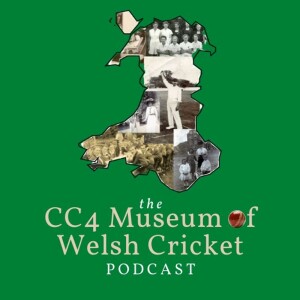
CC4 Museum of Welsh Cricket Podcast
Sports:Cricket

Tell us what you think of this episode
This week’s episode features Tony Cordle. Featured below is Tony’s profile on the CC4 Museum of Welsh Cricket website (https://www.cricketmuseum.wales/)
We would like to place on record our thanks to Michael Cann of Cardiff Cricket Club for enabling us to contact Tony for this interview
CORDLE, Anthony Elton.
(birth registered as Elton Anthony Cordle) Born - Bridgetown, Barbados, 21 September 1940.
Professional. 1st XI: 1963-1982. 2nd XI: 1962-1980. Club and Ground:1972-1976.
Cap: 1967.
Clubs: Cardiff, Pontyberem.
Career-bests
First-class - 81 v Cambridge University at Margam, 1972.
9/49 v Leicestershire at Colwyn Bay, 1969.
List A - 87 v Nottinghamshire at Trent Bridge, 1971.
5/24 v Hampshire at Portsmouth, 1979.
Glamorgan have always been known as a good social team, with many fine singers in their ranks. During the 1930s George Lavis (Vol.2, p155-158) had led the team after they had been invited to sing on stage at several seaside resorts. Their repertoire before the Second World War always featured a number of traditional Welsh melodies, but by the 1960s and 1970s the sing-songs included a series of West Indian calypsos, thanks to the input of Tony Cordle, the Club’s first overseas fast bowler with the Bajan long after retiring from playing, continuing to delight with his lilting voice – albeit in Canada!
Tony was brought up in the Deacon’s Housing Area, just outside Bridgetown and played a decent standard of club cricket in Barbados. His half-brother Frank King had been a Test fast bowler, whilst his father had captained a strong team in the Barbados Cricket League competition. However, Tony was still a novice as far as cricket was concerned when, shortly after his 21st birthday, he decided to follow the example of his older brother Steve and move to the United Kingdom.
He initially worked for London Transport, but after ten days – “the most frightening ten days of my life” he later admitted – he decided to move to Cardiff where his brother and sister were now based. A few days later, he went to the Labour Exchange in Westgate Street ostensibly to secure a job with British Railways. Whilst t walking up the stairs he looked out on the Arms Park cricket ground. “I saw the green turf and the scoreboard – the first friendly sights I had seen in Britain.”
Having fond memories of playing cricket in Barbados, Tony contacted Cardiff CC, little realising that his decision in February 1962 would dramatically transform his life.
Wyndham Lewis, the Cardiff secretary, was soon impressed – so were Wilf Wooller and Phil Clift, the captain and coach respectively of Glamorgan’s 2nd XI and later that summer Tony made his debut for Glamorgan’s second string, claiming four wickets against Warwickshire at Ebbw Vale.
After a clutch of wickets in club cricket, besides frightening opponents with his sheer pace and fast arm, Tony received further coaching from the Glamorgan staff, plus captain Ossie Wheatley who taught him important lessons about variations of pace and swing. “I could spray it around at first, “ he admitted. “Direction and getting things right against the professionals used to worry me, but I cut down a bit on pace and learnt how to move the ball around both ways. I worked at it endlessly until it all came right. It was then I realized that bowling quick was not everything and that made me a more effective bowler. “ He could still however produce an express delivery and one of his happiest recollections in a Glamorgan sweater had been clean bowling Hampshire’s Barry Richards almost before the great South African batsman could pick his bat up!
He agreed professional terms with Glamorgan for 1963, although he contin
More Episodes
 2024-11-01
2024-11-01
 2024-08-02
2024-08-02
 2024-07-26
2024-07-26
 2024-07-19
2024-07-19
 2024-06-20
2024-06-20
Create your
podcast in
minutes
- Full-featured podcast site
- Unlimited storage and bandwidth
- Comprehensive podcast stats
- Distribute to Apple Podcasts, Spotify, and more
- Make money with your podcast
It is Free
- Privacy Policy
- Cookie Policy
- Terms of Use
- Consent Preferences
- Copyright © 2015-2024 Podbean.com





